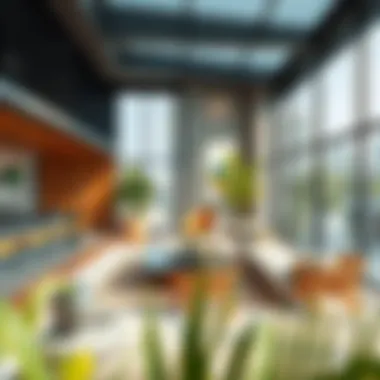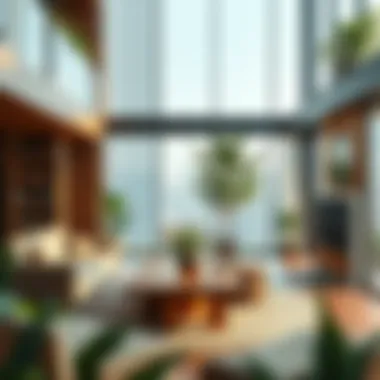Exploring Bloom Living: Sustainable Urban Solutions


Market Trends and Analysis
Current Market Conditions
In recent years, the landscape of urban living has been undergoing significant changes as the demand for sustainable solutions rises. Cities around the globe, particularly high-energy metropolises like Dubai, are witnessing an evolution in their architectural and community frameworks. There's a clear shift towards incorporating green elements in urban design—a movement driven by ever-increasing urban populations and the pressing need to combat climate change.
According to reports from various real estate market analysts, properties designed under the principles of sustainable living have gained notable traction. These dwellings not only appeal to the environmentally conscious buyer but are increasingly regarded as smart investments. The performance of such properties tends to withstand market fluctuations better than their traditional counterparts, leading to a surge in interest from both local and international investors.
Future Projections and Opportunities
Looking ahead, the future appears promising for sustainable urban living initiatives. Predictive analyses indicate that the demand for eco-friendly homes will continue to increase. For instance, cities like Dubai are embarking on projects where urban greenery is prioritized, aiming for a carbon-neutral footprint. This presents a golden opportunity for investors and developers alike.
Investors eyeing the sustainability sphere should consider the integration of technology into these living spaces. Smart home features that optimize energy consumption not only enhance comfort but are fast becoming a standard expectation among buyers. There is a substantial market for retrofitting older properties with sustainable features as well.
Still, it's not just about the buildings themselves; community engagement plays a vital role. Initiatives that foster connections among residents and promote shared resources can create a sense of belonging. Investors focusing on developing environments where interaction flourishes stand to reap not only financial rewards but also the intrinsic value of cultivating vibrant communities.
"The future of urban living lies in balancing modern convenience with eco-conscious practices. It's a win-win for the planet and profit."
Investment Strategies
Best Areas for Investment
Investing in Bloom Living projects requires strategic insight into market dynamics. Key areas to watch include mixed-use developments where residential, commercial, and green spaces coalesce. In Dubai, areas like Dubai Creek Harbour and Aljada showcase innovative designs, reflecting a sustainable ethos while attracting a diverse audience of buyers.
When considering investment, focus on regions that are part of broader sustainability initiatives. Look for government and private partnerships that emphasize renewable energy and water conservation, as these factors often signify stability and growth potential.
Tips for Property Investors
Successful investments in sustainable urban living products can be achieved through careful planning and awareness of market trends. Here are some tips that may aid in your investment journey:
- Research the Local Market: Understanding the area's demographics, lifestyle preferences, and economic indicators can provide valuable insights.
- Network with Local Developers: Engaging with builders specializing in sustainable architecture opens avenues for potential investments and collaborations.
- Evaluate Technological Integration: Properties equipped with the latest green technologies often attract higher valuations and lower operational costs.
- Consider Long-term Gains: Sustainable properties may exhibit slower appreciation initially but tend to hold value over time, thanks to the increasing relevance of eco-friendly practices.
- Stay Informed: Regularly update your knowledge on sustainable trends in urban planning and architecture. Websites like Britannica and Encyclopedia offer rich resources for ongoing education.
By navigating the evolving landscape of Bloom Living with informed choices and strategic approaches, investors can position themselves for both profitable gains and a meaningful impact on their communities.
For further reading and updates, you might find resources at reddit.com or explore discussions on Facebook, where urban sustainability topics flourish.
Understanding Bloom Living
Understanding Bloom Living is more than just grasping a concept; it’s about embracing a lifestyle that aligns with the demands of contemporary urban existence while keeping sustainability at its core. In a world where pollution and climate instability are constant challenges, this notion offers a viable path. It speaks to the heart of a community-driven approach that seeks to enhance quality of life through green practices and technology integration. This section lays the groundwork for comprehending how such a lifestyle can transform cities and enrich the lives of their inhabitants.
Defining Bloom Living
To define Bloom Living, we must consider its multifaceted nature. At its essence, Bloom Living represents a synthesis of ecological awareness with urban development. It urges designers, architects, and ordinary citizens alike to recalibrate their perceptions of living spaces.
- Eco-centric principles: Central to Bloom Living is the idea of eco-centric living. This means prioritizing the environment in all decisions — whether it be sourcing materials for construction, designing urban spaces, or creating community programs.
- Integration of nature: Bloom Living promotes the integration of natural elements into urban designs, leading to the construction of buildings that not only consume less but also produce energy through renewable sources.
- Community focus: It's not merely a collection of green buildings but a lifestyle that encourages community interaction. Think of neighborhood gardens, local farmers' markets, and communal spaces that foster relationships among individuals.
Bloom Living isn't just a trend; it’s a manifesto for how we should rethink our urban landscapes.
Philosophical Underpinnings
Delving into the philosophical aspects, Bloom Living draws on various schools of thought to advocate for a shift towards sustainability. These philosophical underpinnings foster a sense of collective responsibility towards our environment and society.


- Social equity: The core belief is that everyone should have access to sustainable living, which necessitates efforts to create affordable housing and inclusive communities.
- Environmental stewardship: This concept encourages individuals to nurture and protect the environment. A town focused on Bloom Living may offer educational programs highlighting the importance of biodiversity and ecosystem balance.
- Well-being and health: Philosophically, there's an acute awareness of how urban living impacts mental and physical health. Emphasizing walkable communities, green spaces, and active transportation links Bloom Living with improved well-being.
Bloom Living is not just about buildings; it is a broader movement seeking to redefine our relationship with our habitat. It urges us to consider how our choices today shape the urban landscape of tomorrow, ensuring it flourishes for generations to come.
"Sustainability is not a destination; it’s a way of life."
By weaving these philosophical threads into our understanding of Bloom Living, we create a richer tapestry that illustrates its significance in contemporary society.
The Importance of Sustainability
The change in our environment is hardly a passing phase; it’s a reality we can no longer ignore. Across the globe, cities are facing increasing challenges – pollution, overcrowding, and resource depletion, to name a few. Sustainability, in this context, plays a pivotal role in shaping our urban landscapes. By focusing on sustainable practices within Bloom Living, we can foster environments that promote health, community, and ecological integrity.
Environmental Impact
Undoubtedly, the most pressing aspect of sustainability is its environmental impact. Urban areas are often the largest contributors to greenhouse gas emissions, and sustainable living acts as an antidote to this problem. One approach involves integrating green building practices, which utilize materials that reduce carbon footprints, such as reclaimed wood or recycled steel. This not only safeguards resources but also emphasizes the importance of reducing waste.
Moreover, initiatives like urban farming can mitigate food miles. Imagine cities increasingly dotted with vertical gardens or rooftop farms. These not only use less space but also provide fresh produce right where it's consumed, minimizing transportation emissions.
"Sustainable practices are not just about preserving the environment; they also contribute to the beauty of urban living."
Additionally, biodiversity emerges as another crucial element. Urban green spaces, parks, and tree-lined avenues serve more than aesthetics; they foster healthier local ecosystems. By planting local flora, cities can support wildlife and maintain ecological balance, contributing to a resilient urban environment. Furthermore, the lessening of the urban heat island effect, where cities trap heat, becomes a possibility through these eco-friendly initiatives.
Social Responsibility
Sustainability goes hand in hand with social responsibility. Cities are melting pots of cultures but often face inequality in resource distribution. Implementing sustainable measures highlights our obligation to those around us. For instance, creating equitable access to green spaces, transportation, and health resources can significantly enhance the quality of urban life.
A great example is community-driven projects like neighborhood gardens or recycling programs. Such initiatives not only engage residents but also instill a sense of ownership and pride. Residents who feel connected to their environment are more likely to invest in their community, bringing about a positive cycle.
Furthermore, social responsibility extends beyond immediate neighborhoods. It's crucial for urban developments to prioritize sustainable business practices that favor local economies. By utilizing local materials and labor, businesses contribute to the regional economy while reducing transportation costs and emissions.
Economic Advantages
While the environmental and social aspects are of utmost importance, we cannot overlook the economic benefits of sustainability. Investing in sustainable infrastructure often leads to long-term cost savings. This is largely due to reduced energy, water, and waste management costs. For example, buildings designed with energy efficiency in mind often see significant reductions in utility bills, a boon for both owners and tenants alike.
Moreover, there is a growing trend in the real estate market, where properties that embrace sustainability tend to attract higher values. Investors, agents, and buyers are increasingly recognizing the value proposition of sustainable living. Properly designed sustainable projects not only help the planet but pay dividends in property value over time.
- Increased market demand for sustainable properties
- Reduced operational costs for both residents and businesses
- Potential for government incentives and tax rebates for green initiatives
As the shift towards sustainability becomes imperative, cities like Dubai have the opportunity to lead globally. By embedding these principles deeply into real estate and urban planning strategies, it might just pave the way for a more sustainable future, both economically and environmentally.
Architectural Innovations
The world of urban living constantly evolves, and at the forefront are the innovations in architecture that emphasize sustainability and efficiency. These innovations are essential in shaping how communities function, fostering an environment where nature and urbanity coexist harmoniously. By integrating principles of ecology with contemporary design, we can harness architectural innovations to not just beautify our cities but also enhance their functionality.
Green Building Materials
The core of sustainable architecture lies in the materials we choose. Green building materials are crafted to minimize environmental impact while offering durability and aesthetic appeal. This includes using recycled resources, locally-sourced timber, and eco-friendly insulation options. Such materials not only reduce carbon footprints but also improve indoor air quality, providing healthier environments for residents.
Common examples include bamboo flooring, which is not only renewable but also highly resilient, and reclaimed wood that tells a story while promoting sustainability. Incorporating these materials might have higher initial costs but pays off in longevity and lower maintenance expenses down the line.
"Choosing the right materials is like laying a foundation for a future where sustainability isn't an option, but a norm."


Energy Efficiency Solutions
Next on the list is energy efficiency, which encompasses a wide array of strategies and technologies that reduce energy consumption in urban living spaces. The installation of solar panels, high-efficiency appliances, and smart thermostats are just a few means through which architects can promote sustainable energy use. Utilizing passive solar design techniques also plays a significant role—buildings oriented to optimize sunlight can reduce reliance on artificial lighting and heating, benefiting both the environment and the wallet.
Moreover, energy-efficient buildings often qualify for tax incentives and grants aimed at promoting sustainable practices, further encouraging investment in these innovations.
Water Conservation Techniques
Water conservation is an often-overlooked aspect of architectural innovation. Effective techniques here can include rainwater harvesting systems, greywater recycling, and drought-resistant landscaping. Implementing such systems not only reduces the burden on municipal water systems but also promotes a culture of conservation among residents.
Urban rain gardens and permeable pavements can help manage stormwater runoff, thus preventing flooding and preserving local water quality. In regions where water scarcity is an ever-looming concern, these techniques can be a game-changer, ensuring that cities remain resilient even in the face of changing climate conditions.
Overall, architectural innovations are not merely about constructing buildings that look good. They embody a strategic approach towards creating sustainable communities that are adaptive to the challenges of modern urban life. Investors, agents, buyers, and analysts must pay heed to these developments, as they hold the key to the future of urban living.
Community and Urban Regeneration
In the landscape of urban development, community and urban regeneration play a pivotal role in shaping cities that are sustainable, livable, and inclusive. As we dive into Bloom Living, it becomes clear that understanding how communities can revitalize urban spaces is essential for future growth. Focusing on principles that encourage social responsibility, environmental sustainability, and equitable economic development, community engagement becomes the cornerstone of any successful regeneration effort.
Fostering Community Engagement
Understanding that residents should be more than just beside of buildings, fostering community engagement transforms the dynamic within urban settings. This process is about inviting individuals to feel a sense of ownership over their neighborhoods and actively participate in their development. Some ways that communities can get involved include:
- Local Workshops: Hosting events where community members can voice their opinions, express their desires, and collaborate on development strategies.
- Art in Public Spaces: Artistic expression can serve as a powerful means of bringing neighbors together, sparking conversation and cultivating a sense of identity.
- Volunteer Programs: Having residents participate in cleanup drives, tree planting, or mentorship programs encourages a strong bond among neighbors.
These activities not only enhance residents' connections to their environment but also foster a sense of pride. Moreover, empowered individuals tend to be more invested in sustainable practices that enhance their living spaces.
Public Spaces and Green Areas
Public areas act like the beating heart of a community. Parks, gardens, and recreational zones become spaces where families gather, friends meet, and communities thrive. Thus, integrating ample green areas is critical. A few benefits of such spaces include:
- Environmental Gains: Green areas help mitigate urban heat, improve air quality, and provide biodiversity for local flora and fauna.
- Social Cohesion: Well-designed public spaces facilitate social interactions and encourage diverse groups to mingle.
- Health Benefits: Green spaces promote physical activities like walking, jogging, or yoga, contributing to improved physical and mental well-being.
Technology's Role in Bloom Living
In an era where urban living is evolving at breakneck speed, technology has emerged as a critical component shaping sustainable landscapes. The intersection of technology and sustainable practices within urban environments offers a framework for enhancing efficiency, while also fostering a harmonious relationship between humans and nature. In this section, we will explore how technology is paving the way for innovative models of living that not only meet today’s environmental challenges but also improve the quality of life for residents.
Smart Home Implementation
Smart home technology has revolutionized the way we think about home environments by integrating automation and connectivity. Systems that manage lighting, heating, and even appliances can now be programmed to operate more efficiently, leading to significant energy savings. For instance, smart thermostats like the Nest Learning Thermostat not only adjust temperatures based on the homeowner's habits but also provide energy usage reports. This data empowers homeowners to make informed decisions regarding their consumption patterns.
Benefits of Smart Home Technology:
- Energy Efficiency: Automatically adjusting energy usage to only when needed cuts down on waste.
- Enhanced Comfort: Personalized settings that adjust to individual preferences improve quality of life.
- Security Features: From smart locks to security cameras, technology can ensure a safer living space.
However, the installation and maintenance of smart home systems can come with hurdles. High upfront costs, varying compatibility between devices, and privacy concerns are points of consideration for potential users. As these technologies continue to develop, balancing these factors will remain pivotal in driving their adoption within sustainable communities.
Sustainable Urban Tech
Sustainability in urban areas is no longer merely a lofty goal; it's quickly becoming a necessity. Sustainable urban tech encompasses innovations designed to minimize the ecological footprint of cities. Solutions like green roofs, solar panels, and smart grids are at the forefront of this movement. These technologies enhance resilience while addressing climate change, water scarcity, and energy demands.
For example, cities are increasingly implementing smart grids that optimize electricity distribution based on real-time demand. This not only reduces energy wastage but allows for increased integration of renewable energy sources.


- Smart Waste Management: Systems that use sensors to monitor waste levels can optimize collection routes, cutting down on fuel consumption and labor costs.
- Urban Mobility Solutions: Electric scooters and bike-sharing programs reduce reliance on cars, curbing emissions and traffic congestion.
- Vertical Farming Technologies: These ensure local food production in urban settings, thereby decreasing the carbon footprint associated with transporting goods.
"Integrating technology into urban environments isn't just about efficiency—it's about creating a sustainable future where communities can thrive without compromising the planet."
For further insights into this evolving landscape, consider exploring resources at Wikipedia and Britannica.
Investing in Bloom Living Projects
Investing in Bloom Living projects is not just about putting money into a property; it’s about embracing a lifestyle that prioritizes sustainability within urban environments. As the world faces increasing challenges related to climate change and population density, the need for sustainable living solutions becomes more pressing. Therefore, potential investors must consider key factors that highlight the importance of these projects.
Market Trends in Sustainable Properties
The real estate landscape is rapidly evolving, especially in areas linked to sustainable development. Investors can no longer afford to ignore trends favoring eco-friendly and sustainable properties. The shift towards these buildings is driven by several factors:
- Demand for Sustainability: Nowadays, consumers, especially younger generations, prefer homes that reflect their values, which often include environmental responsibility.
- Government Incentives: Various local governments offer incentives for green building initiatives, like tax rebates and grants, which sweeten the deal for potential investors.
- Rising Awareness: More people understand the benefits of energy-efficient buildings, leading to a surge in the demand for such properties.
With statistics showcasing the growth in sustainable property appreciation, it’s clear that investors who capitalize on these trends stand to gain significantly.
Risk and Return Analysis
Investing in Bloom Living projects is not without its inherent risks; however, the potential for return is noteworthy. The key is to conduct a thorough risk assessment.
- Market Fluctuations: The real estate market can be quite volatile. Knowing when to invest is crucial; entering at the right time can maximize returns.
- Regulatory Changes: Policies around sustainability are evolving. A sudden law change can affect property values.
- Construction Risks: Projects can face delays or budget overruns. Thus, due diligence on developers is essential.
However, the long-term benefits generally outweigh these risk factors. Sustainable properties often see higher occupancy rates and lower turnover, leading to steady income. Plus, eco-friendly buildings usually come with lower operational costs, making them more attractive in the long run.
Case Studies of Successful Developments
To understand the implications of investing in sustainable projects, let’s examine a few successful developments:
- The Edge in Amsterdam: Often hailed as one of the greenest buildings in the world, its energy-efficient design has led to high demand and increased property value.
- One Central Park in Sydney: This residential project integrates green spaces and innovative design, attracting high-end tenants and stimulating local economies.
- Brockton Park in Toronto: A mixed-use development that features sustainable building materials and renewable energy sources has not only enhanced the local community but also generated significant returns for investors.
These examples underline the inherent potential of investing in sustainable urban living projects. With the shift towards more responsible living, the landscape and economics of urban development are undoubtedly transforming, paving the way for future infrastructure that respects ecological boundaries while meeting human needs.
End
As we reflect on all aspects of Bloom Living explored throughout this article, it becomes clear that sustainable urban living isn't just a passing trend; it’s a necessary evolution for the future. This concept aggregates various elements, from green architecture to community engagement, crafting a holistic lifestyle that benefits not only individuals but society as a whole.
Future of Bloom Living
The horizon for Bloom Living appears ever more promising as technological advancements and increasing awareness propel cities toward sustainability. With smart urban solutions allowing for efficient energy use and enhanced quality of life, we stand at a pivotal intersection where eco-consciousness meets urban expansion. Expect to see:
- Expansion of Green Spaces: Urban areas will further prioritize parks, gardens, and community plots that enhance biodiversity and improve air quality.
- Innovative Building Designs: Architects and developers will deploy materials that comply with sustainable standards while offering aesthetic appeal. Buildings designed with the LEED certification in mind will be more common, fostering better indoor environments.
- Integration of Renewable Energy Sources: Solar panels and wind turbines will become not just optional add-ons but standard features in all new buildings, drastically reducing reliance on non-renewable energy.
- Community-Centric Urban Planning: As cities evolve, the focus will shift markedly toward community well-being, with spaces designed to foster interaction and belonging.
Collectively, these trends signal a persistent move towards a future where urban living coexists with nature. However, a collaborative approach will be crucial, demanding the input of local governments, citizens, and businesses alike.
Call to Action for Investors
Investors play a vital role in driving the Bloom Living agenda forward. With the real estate market adapting to sustainability trends, now's the time for those inclined to take a leap into sustainable projects. Here’s why:
- Potential for Returns: Properties that prioritize sustainability often command higher resale values and attract a broader pool of environmentally-conscious tenants.
- Regulatory Incentives: Local governments increasingly offer tax breaks and financial incentives for projects that meet strict sustainability criteria, further enhancing ROI.
- Changing Consumer Preferences: The shift towards sustainable living is altering consumer priorities. Prospective tenants and homeowners are actively seeking greener options to rent or buy, making it a smart move for investors to pivot.
Investors should not just see this as a financial opportunity, but as a responsibility toward their communities and the planet. Investing in Bloom Living initiatives can pave the way for long-term growth, benefiting both portfolios and the environment.
"The greatest threat to our planet is the belief that someone else will save it." — Robert Swan
In summary, the blend of sustainability with urban living is no longer an idealistic dream, but a tangible reality with significant implications for investors looking to reap benefits while contributing positively to the environment. The landscape is shifting, and those who adapt early will lead the charge toward meaningful change.
For further insights, consider exploring resources such as Wikipedia on Sustainable Living or the US Green Building Council for an in-depth look at green construction methodologies.











